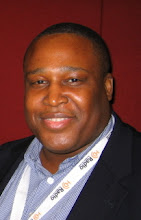Here's an email that I sent out to last week to attendees of the NAB/R&R conventions. You may find this information useful when planning your networking goals to make the most of the next conference or convention you will be attending.******
Everyone in our industry is excited about the NAB/R&R conventions convening now in Dallas. While enjoying the standing room only sessions, take a moment to notice who is standing next to you. Could it be a new potential client or ally, or another industry insider or an old friend?
To make the most of your convention networking, here’s some great advice from master networker Keith Ferazzi on connecting with connectors.
15 tips to help you become a
Conference Commando:
Tip #1: Remember the 7P’s: Prior Planning Prevents Piss-Poor Performance – Get focused. Think about: Why you are attending? What you want to achieve? Who you want to meet?
Tip #2: Know your targets. Get a list of conference attendees and keep that list with you at all times during the conference so you will know whom you’ve met and who you still need to meet.
Tip #3: Gather intelligence. If you want to get to know someone, the first thing you should do is figure out how you can help them. Find your currency for them—your experience, knowledge, contacts or resources that can make them more successful.
Tip #4: Strike early. Don’t wait until the conference to start your networking.
Tip #5: Never attend a conference. Well, never just attend a conference. You should be sure to speak, too, even if your name isn’t on the program. Acquire a 30-second commercial for your brand by asking a thoughtful question during Q&A.
Tip #6: Slight the speakers. Don’t waste time standing in line to meet a speaker after his or her song and dance. There will be so many other brilliant people at the conference; go meet them!
Tip #7: Get a wing man. Start more of the relationships you want. Team up with a partner. You and your buddy can provide each other motivation, guidance and assistance.
Tip #8: Draft off a big kahuna. Get to know some of the most well-known folks at the conference or the conference organizers themselves and hang with them. The important people will rotate by them sooner or later. If you’re there, you’ll meet everyone who matters.
Tip #9: Be an info-hub. Get really familiar with the conference program. Then pick the brains of the conference staff and anyone else willing to share the ins and outs of what’s happening in and around the big meeting. If you’re in the loop on the private parties and after-hours special events, everyone will come to you for the goods.
Tip #10: Work hard on break. Don’t run off to stuff your face or check e-mail between sessions. You should attend to your bagel and BlackBerry while boring speakers are blabbing on and on, so when break time comes, you can get out there and do what you really came to the conference to do—meet people!
Tip #11: Hijack a dinner. True commandos aren’t constrained by the agendas they receive at registration. Arrange a dinner at a special place out on the town you’re visiting with people who care about a particular topic that matters to you, or modify a conference meal that’s already paid for by inviting specific people to join your table as you meet them during the day.
Tip #12: Let your guard down. When you engage at target contact, skip the small talk and dive into the stuff that really matters to you and them: interests, passions, struggles, and greatest needs. Intimacy and Giving are the two keys to making quick connections that jumpstart lasting relationships.
Tip #13: Master the Deep Bump. Once you’ve successfully taken your conversation with a new acquaintance down deep, past the shallow small talk, secure an invitation to reconnect later. Then bump! Move on and meet more people. You’ve invested too much time and money in this conference not to take the opportunity to meet many different people. You have a lifetime to build relationships with people at the conference, but only a few days to meet them.
Tip #14: Take names (and notes). Before you conclude the Deep Bump, and move on after making a new acquaintance, be sure to get a business card. Flip over the card and jot down a few words to remind yourself of what you two discussed, any relevant personal details you wish to remember, and, of course, when and why you’re going to follow up later.
Tip #15: Follow up or fail. Don’t wait until you return home from the conference to ping people whose cards you collect. Shoot out follow-up emails each night of the event or write them during your flight home.
For more from Keith Ferazzi:
Visit http://www.ferrazzigreenlight.com/nevereatalone/
Enjoy the NAB/R&R conventions and let me know your thoughts on the most inspiring sessions, insights and speakers.
Think strategically, act passionately and engage emotionally!
Warmest,
George “Geo” Cook
Audio Entertainment & Marketing Strategist
geometricmedia@gmail.comPhone – 843.278.5664
Cell – 843.513.9652
AIM – geometricmedia



